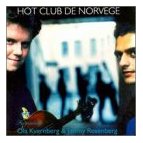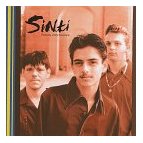

Home | News | Music | Galleries | Museums | Entertainment | Clubs | Cinematic Picks | Reviews | Dining | Store Front | Links | Credits | Contact Us | Disclaimer
J a z z R e v i e w s
Go back to Jazz Music
Film Reviews
Stage Reviews
Television and Cable Reviews
Classical
Music Reviews
Folk Music Reviews
New Age
Music Reviews
Pop
Music Reviews
Underground Music Reviews
Comedy Reviews
Eateries Reviews
Rosenberg, Jimmy:


Jimmy Rosenberg: Hot Club de Norvege and Sinti
Jimmy Rosenberg plays Gipsy Jazz; yes that is what I said Gipsy Jazz. At 23 this young performer is a force. He was born in 1980 in Helmond a city in The Netherlands. His virtuosity at age sixteen on the CD Sinti is said to be a bit flashy, but that is an error by the misinformed. Sinti showcases Jimmy Rosenberg as a virtuoso, it is an excellent disc and it will go down as a classic. It is meant to be flashy, as it pays homage to Django Reinhardt. Django Reinhardt was famous for his speedy guitar work. I highly recommend Rosenberg’s work.
Bostonboy, review
Lang, Jonny:
Jonny Lang - Long Time Coming
It's not important where you've been, but where you are, and at 22, Jonny Lang
is right where he wants to be. Though his past awards, commendations and
achievements are enough - including having two platinum selling albums and a
Grammy nomination by age 19 - Jonny comments, "I'm the happiest I've ever been,
and I've just finished recording an album I couldn't be happier with."
It has been four years between releases. This is an excellent album and was well
worth waiting for; it is well polished and ready for primetime.
Long Time Coming
Bostonboy, review
Jarrett, Keith: pianist
Keith Jarrett - Always Let Me Go (ECM)
Keith Jarrett has many styles. Here, this is a free jazz event.
Free jazz in the 1960s and 1970s had varied consequences. Indeed, it was about
energy and social revolution, befitting the "zeitgeist" of the time. However,
its worst manifestation resulted in stale, lazy and undisciplined musical
productions, as it has been a problem with so much of American rock music.
Now, fear not. Here, pianist Keith Jarrett, bassist Gary Peacock and drummer
Jack DeJohnette give us an exhilarating and entrancing date. Everyone was
focused. Make no mistake, this is an excellent disc.
Always Let Me Go takes listeners on a wonderful journey of musical creation. The
team chemistry of the trio gripped its Tokyo audience (this is a live
recording). One can feel it.
The eight tracks on this 2-CD set are not to be defined as "songs". These pieces
are magnificent explorations. Everything is inspired, and there is an
unmistakable sense of purpose. Meaningful expositions are juxtaposed with
swinging music, avant-garde dense textures, as well as lyrical statements, or,
understatements.
This music will yield great rewards to those who keenly listen. So, be patient
with it. Insights into the workings of jazz creation, such as balance and
co-operation, will be revealed to those who really listen.
Always Let Me Go / Live in Tokyo
Andrew Lee, reviewer
Coltrane, John: saxophonists
John Coltrane - A Love Supreme
Many classical composers are famed for dying young. Well, dying young is also hardly a rare occurrence in the jazz sphere, certainly around the year 1967, when John Coltrane died from liver cancer at age 40. And, he acquired a mystical stature almost as soon as he died...
In those circles that celebrate John Coltrane as a cult figure, he is very often seen as a martyr, indeed, matching the fames of Martin Luther King Jr. and Malcolm X. There is even a San Francisco based church named "St. John Coltrane African Orthodox".
Even he lived a short life, he performed and recorded richly, both in terms of quality and quantity. Look at some of the names he is associated with: Miles Davis, Charlie Parker, Thelonious Monk, Charles Mingus, Sonny Rollins, Bill Evans, Art Blakey, Freddie Hubbard, Dizzy Gillespie, McCoy Tyner, and, many, many, many more. Anyway, amongst the countless number of events and recordings, one recording is almost completely responsible for his sanctified status.
This record was made in 1964. This work, measuring almost 33 minutes long, is called "A Love Supreme". It is a spiritual outpouring in majestic proportions. Let me draw a few parallels: think of Citizen Kane among films, Light in August in literature, and, Sgt. Pepper's Lonely Hearts Club Band in rock.
In terms of musicology, this album stands at the juncture between John Coltrane the bebop practitioner and John Coltrane the avant-garde visionary. As well, it made jazz a vehicle for spiritual exploration.
I have just read Ashley Kahn's book on the making of this album, which is titled "A Love Supreme: The Story of John Coltrane's Signature Album". This book just arrived into stores in conjunction with the release of a 2-CD set of the studio takes, plus the recording of the only public performance of this work, which was made in 1965, in Antibes, France.
This book has a stench of hero worship in various places. But, taken into the context apropos, one can appreciate that every attempt was made to explain how an album with this amount of intensity, fire and complexity became one of the hottest selling jazz albums.
Now, taking historical context into consideration, it's clear that this album came at a time when conditions allowed its unqualified fame. It broke down every barrier: racial, musical, artistic, political, religious, etc. In Jamaica, the Rastafarian Movement was under way, to illustrate a point.
A Love Supreme embraces musical influences far and wide, from Stravinsky to Thelonious Monk to Indian chants, etc. And, of course, centrally, it deals with John Coltrane's spiritual direction.
One must remember that John Coltrane was in a bad shape in 1957, when he was addicted to heroin and booze. Essentially, Miles Davis, his boss at the time, told him to clean up his act before joining him again. Indeed, after hard self-searching, he was able to recover, and, remarkably, with an otherworldly strength. He re-joined Miles Davis in 1959, just before Kind of Blue, another great landmark jazz album.
When A Love Supreme was released, it was not warmly welcomed by critics. But, it was promoted by devoted fans, so that the sales figure went over 100,000, which is a high number for jazz recording sales, both then and now.
The musicians who were involved in this knew from the start that they had created something exceptional. Recently, I saw Elvin Jones (the drummer who played in the recording) in an interview, and, he remarked how exhausted they were after the takes and how they were really high at the same time. I saw the spark in his eyes when he uttered the word "sacred".
John Coltrane was lucky that he had top-notch musicians with him: Jimmy Garrison (bass), Elvin Jones and McCoy Tyner (piano). They fuelled his passion.
We thank Rudy Van Gelder too, who is the legendary engineer of
so many great jazz albums, including this.
If this is new to you, please make the effort to acquaint yourself with its
power and its utmost sincerity.
The Recording:
Love Supreme (Deluxe Edition) [Original Recording Remastered]
Ashley Kahn's book - A Love Supreme: The Story of John Coltrane's Signature Album
Ashley Kahn's other books, recommended:
Kind of Blue: The Making of the Miles Davis Masterpiece
Rolling Stone the Seventies: The Seventies
The Seventies
Andrew Lee, reviewer
Garbarek, Jan: saxophonists
At age fourteen Jan Garbarek was exposed to the genius of John Coltrane and his life was never the same. He purchased a how to book on the saxophone and taught himself fingering before he even acquired an instrument. Ragas and Sagas and Twelve Moons are two excellent examples of his talent.
Bostonboy, review
Zanella, Jean-Pierre: saxophonists
Jean-Pierre Zanella - Mother Tree (Effendi)
Jean-Pierre Zanella is one of Canada's première saxophonists. And, for the
French Canadians, he is likely their top choice. He has done everything from
worldbeat to soft pop. This new album called Mother Tree finds him in excellent
form for what he loves the most: jazz (Effendi, FND027).
On this date, all his sidemen are top-notch. He assembled a nice program made up
of bop fireworks and wonderful ballads, giving him every opportunity to extract
a wide range of colors on both soprano and alto saxophones.
You must hear his own "Last Parade of Minishtov". It is blissfully subtle. Its
meter is an odd one, and, it makes a strong impression. Pianist James Gelfand
contributes a love tune called "U and I", in which both he and Zanella glowed
with joy.
This is a memorable disc, and is already getting rave reviews abroad.
Again, as this is so new, I cannot find it anywhere on-line. But, you do have
the catalogue information.
Now, this is his 1997 disc mixing jazz, Brazilian, Latin, Afro-Cuban elements:
Mystic Infancy. It is as equally memorable as
Mother Tree.
Andrew Lee, reviewer
Washington, Dinah:
Dinah Washington - Complete Mercury Recordings
First, Dinah Washington (1924-1963) was born as Ruth Lee Jones. The great Lionel
Hampton (1909-2002) claimed to have given her the name Dinah Washington, but, it
may well have been Joe Glaser, a talent manager who recommended her to Lionel
Hampton. She stayed in Lionel Hampton's establishment between 1943 and 1946,
and, they made records together. Then, she left Lionel Hampton for a solo
career. It was not difficult to do so, because she was by then extremely famous,
hitting the top ten charts on a frequent basis. She covered all kinds of music,
and, she was able to turn any mediocre material into gold, let alone quality
stuff. In this distinction, she was in every way equal to Billie Holiday. In
fact, their vocalisms share common traits. Dinah Washington also had an edge
akin to Sarah Vaughan, the first jazz singer to dazzle me (though I studied
Jimmy Rushing's output first).
She was a temperamental lot. And, she gave everything to her art as much as she
demanded total commitment from all those she worked with. Her life was certainly
eventful, with seven marriages behind her. No wonder she had an interesting way
of singing about failed or lost love. Indeed, she had psychological insight to
everything she laid her vocal chords on. One of her greatest hallmarks is clear
diction. You can hear every syllable.
The Complete Dinah Washington on Mercury is one of the greatest landmarks of
jazz (Note: She also made recordings with the other labels, therefore this is
not her complete works per se, only as far as Mercury catalogue is concerned).
They come in seven boxes, with 3 discs each box. You can start with any box; and,
you will want them all. The documentation is complete. Song texts are supplied
in full. Interesting essays provide insight. Needless to say, the archival and
artistic values of these 7 boxes are immeasurable and irreplaceable. Mercury has done a great job in remastering the sound.
Volume 1 Complete on Mercury (1946-1949)
Volume 2 Complete on Mercury (1950-1952)
Volume 3 Complete on Mercury (1952-1954)
Volume 4 Complete on Mercury (1954-1956)
Volume 5 Complete on Mercury (1956-1958)
Volume 6 Complete on Mercury (1958-1960)
Volume 7 Complete on Mercury (1961)
Andrew Lee, reviewer
![]()

250,00 Music Titles -- CDs, Cassettes, LPs at Collectors' Choice Music
Home | News | Music | Galleries | Museums | Entertainment | Clubs | Cinematic Picks | Reviews | Dining | Store Front | Links | Credits | Contact Us | Disclaimer
©2001-2010 BostonBoy.com